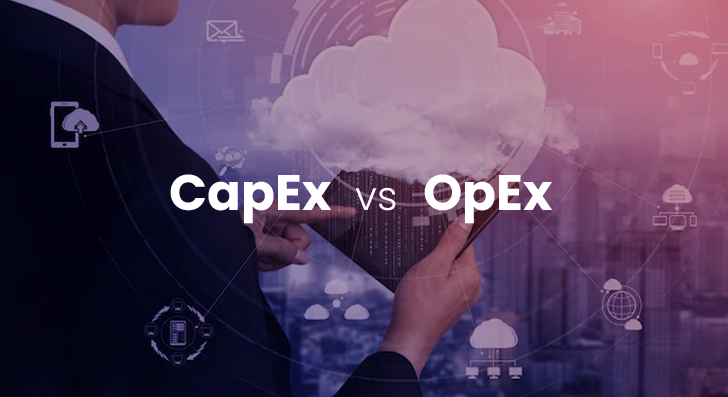Cloud migration comes with many business benefits, including increased agility and flexibility, reduced costs, enhanced data security, improved performance, better consumption management, and more. However, migrating to the cloud is not merely a technological shift, but a strategic financial decision centered around Capital and Operational expenses. A nuanced understanding of OpEx vs CapEx in cloud computing is pivotal for crafting a migration strategy that aligns with an organization’s immediate needs and long-term objectives while maximizing the benefits of cloud migration.
Before taking a plunge into key considerations for successful cloud migration, let’s look at some key differences between these two financial models along with their pros and cons.
| Aspect | CapEx | OpEx |
|---|---|---|
| Initial Cost | High | Low |
| Scalability | Not flexible | Highly flexible |
| Financial Impact | Major impact on capital budget | Impact on operational budget |
| Depreciation | Depreciated over time | No depreciation |
| Technology Updates | Requires periodic upgrades | Continuous updates by the cloud provider |
| Implementation Time | Longer setup and high deployment time | Faster deployment and lower time-to-market |
| Maintenance | Enterprise is responsible for maintenance | Maintenance handled by cloud provider |
| Resource Utilization | Often leads to overprovisioning | Optimized usage, pay for what is used |
| Vendor Dependency | Less dependency | Higher dependency |
Advantages of CapEx and OpEx
CapEx Benefits
1. Ownership and Control
One of the key advantages of CapEx is the full ownership and control it provides over physical IT assets. For instance, when an enterprise invests in data centers, servers, storage, networking equipment, and other IT infrastructure, it retains full ownership of these resources, which translates into complete control over the IT infrastructure. With full control, organizations can not only optimize performance based on their workloads but also perform more precise troubleshooting as they have direct access to all components.
2. Customization
Capital Expenditures (CapEx) offers a high degree of customization for IT infrastructure. When an enterprise invests in data centers, servers, storage, and networking equipment, it gains the flexibility to customize its IT infrastructure to meet specific organizational needs. With Capital Expenditures (CapEx), organizations can configure their hardware and software tailored to their unique needs to optimize the performance of the mission-critical workloads and applications. Furthermore, customization extends the ability to integrate with legacy systems leading to enhanced performance and greater operational efficiency.
3. Enhanced Security
Another significant advantage that CapEx offers is enhanced security. By owning and managing IT resources, organizations can implement stringent security measures tailored to meet their requirements and industry-specific compliance and regulatory standards. Having complete control over the IT infrastructure allows organizations to deploy modern security measures, such as encryption protocols, intrusion detection systems, and dedicated firewalls.
OpEx Benefits
1. Scalability
With the OpEx model, organizations get the flexibility to scale resources up or down based on current demand. This flexibility is highly beneficial for organizations with fluctuating workloads or experiencing rapid growth. For instance, during festive seasons, organizations can easily increase their computing power to handle the massive surge in traffic leading to optimal performance and customer satisfaction. On the other hand, during slower periods organizations can scale down their resource usage to reduce costs.
2. Access to Advanced Technologies
Cloud service providers regularly invest in modern software and hardware to meet the evolving needs of businesses of all sizes. Choosing the OpEx model allows organizations to access advanced technologies without the need for high upfront capital outlay. These advancements typically include sophisticated data analytics tools, AI and ML capabilities, and powerful computing resources. By accessing advanced technologies, organizations can drive innovation and stay competitive in the market.
3. Remote Accessibility
Remote accessibility is another significant advantage of the OpEx model, enabling organizations to access IT resources from anywhere and at any time. This is highly beneficial in distributed work environments, wherein teams work remotely from different parts of the world. In short, remote accessibility not only improves operational efficiency but also allows organizations to stay agile and responsive to changing market demands.
Disadvantages of CapEx and OpEx
CapEx Challenges
1. Maintenance and Upgrades
Though CapEx provides complete control over the IT infrastructure, it demands routine maintenance and upgrades for the upkeep of these assets. This includes system monitoring, software updates, and hardware repairs – all of which require a dedicated team of IT staff. The costs associated with routine maintenance and upgrades of IT resources can accumulate over time, adding to the total cost of ownership (TCO).
2. Disaster Recovery
Disaster recovery poses a significant challenge since it demands significant additional investment in maintaining backup infrastructure, mounting the overall cost of ownership. Organizations need to buy, configure, and maintain duplicate data centers and backup systems to ensure continuity in case of an unforeseen event.
From CapEx to OpEx: The Outlook for AWS Cloud Migration
OpEx Challenges
1. Vendor Lock-in
One key disadvantage of the OpEx model is the risk of vendor lock-in, which usually occurs when organizations are overly dependent on a particular cloud service provider, making it difficult for them to switch to other cloud vendors.
2. Limited Control
Reduced autonomy over IT infrastructure and operations is another major challenge associated with the OpEx model. This simply means that organizations will have limited control over critical aspects, such as system updates, performance optimizations, and security configurations.
Key Considerations When Developing a Cloud Migration Strategy
1. Business Goals & KPIs
It is considered pivotal for decision-makers to clearly define the strategic objectives they would like to achieve from cloud migration – whether it’s related to accelerating innovation capabilities, reducing costs, improving operational efficiency, or enhancing scalability. Understanding these goals helps in selecting the right migration path that aligns with the organization’s long-term vision. Furthermore, decision-makers need to establish key performance indicators (KPIs) to measure success by monitoring progress and ensuring that the migration delivers the desired results. These indicators could include metrics such as application performance, system uptime, cost savings, user satisfaction, and time-to-market for new products or services.
2. Security and Compliance
When crafting a choosing a cloud migration strategy, it is critical to ensure the security of sensitive information. This may entail implementing robust security measures such as access controls, end-to-end encryption, and continuous monitoring to protect sensitive information against potential data breaches. Additionally, organizations that handle sensitive personal, corporate and government data must adhere to industry-specific compliance requirements and regulations, such as HIPAA for healthcare, GDPR for data protection, and PCI-DSS for payment processing.
3. Total Cost of Ownership (TCO) Analysis
Another key consideration for crafting a cloud migration strategy is conducting a detailed cost analysis entailing the total cost of ownership (TCO) for both CapEx and OpEx models. Begin the cost analysis process by identifying all relevant costs such as initial migration costs, routine operational costs, or any hidden fees charged by cloud vendors. Now compare these OpEx costs with the CapEx required for buying and maintaining the IT infrastructure. By understanding and evaluating the costs of both financial models, organizations can not only avoid budget overruns but also ensure a financially sound cloud migration strategy.
4. Migration Strategy
Choosing the right migration path is crucial when devising a strategy for cloud migration. When it comes to cloud migration, organizations must choose a path that allows them to migrate data, workloads, and applications to the cloud with minimal disruption and maximum efficiency. There are several cloud migration strategies available that organizations can consider, such as rehosting (lift-and-shift), re-platforming, refactoring, repurchasing, and retiring. However, the choice of migration strategy depends on factors such as business goals, application complexity, and budget.
Summing Up
As businesses navigate the path for cloud migration, they must evaluate their business goals, technical capabilities, and financial models. In fact, a detailed analysis of these elements will guide them in selecting the right model that aligns best with their operational dynamics and business objectives. If you are also planning to migrate data, workloads, and applications to the cloud, you may consider seeking end-to-end consultation from a reliable partner to make an informed decision.






